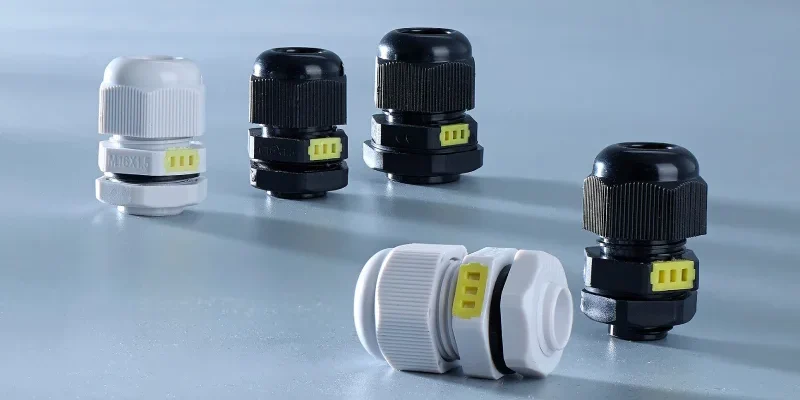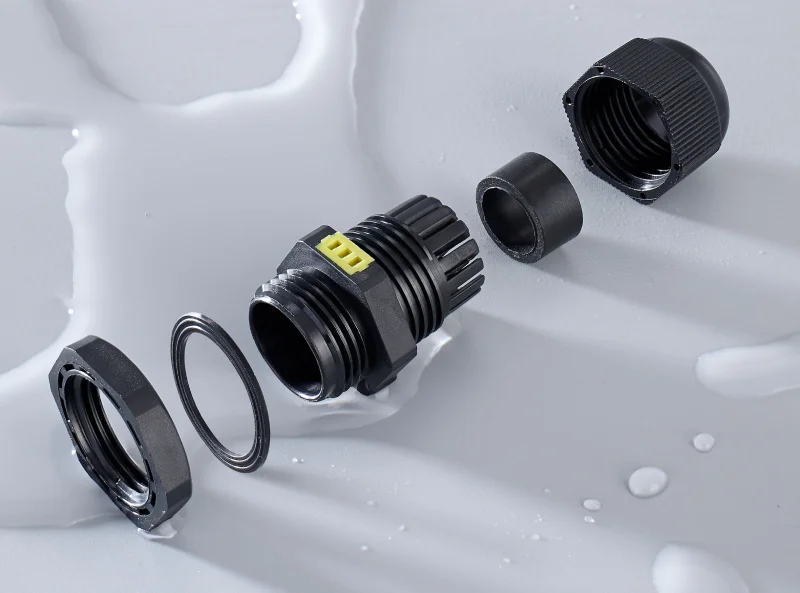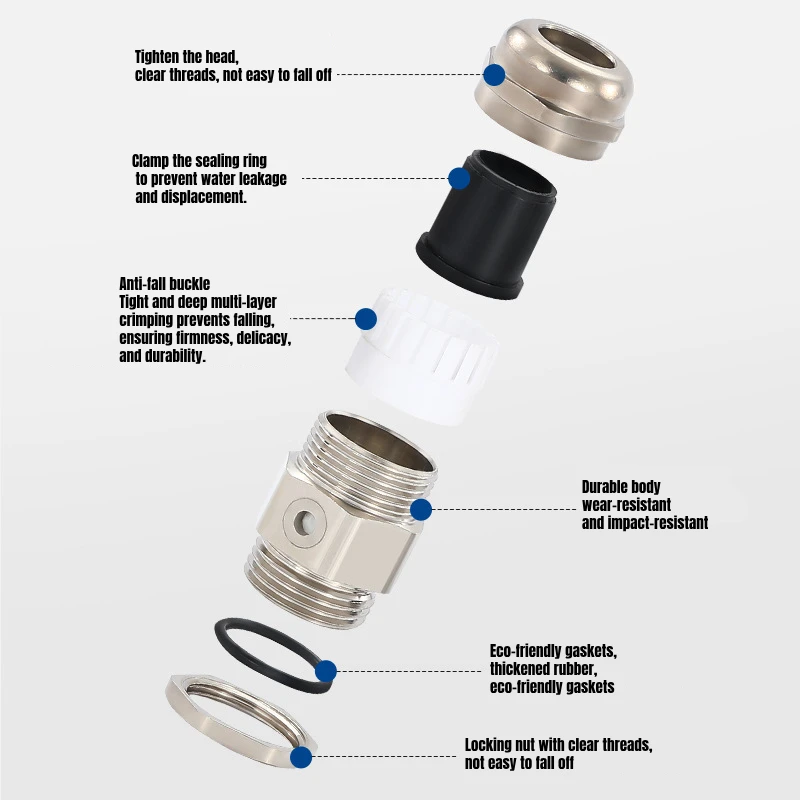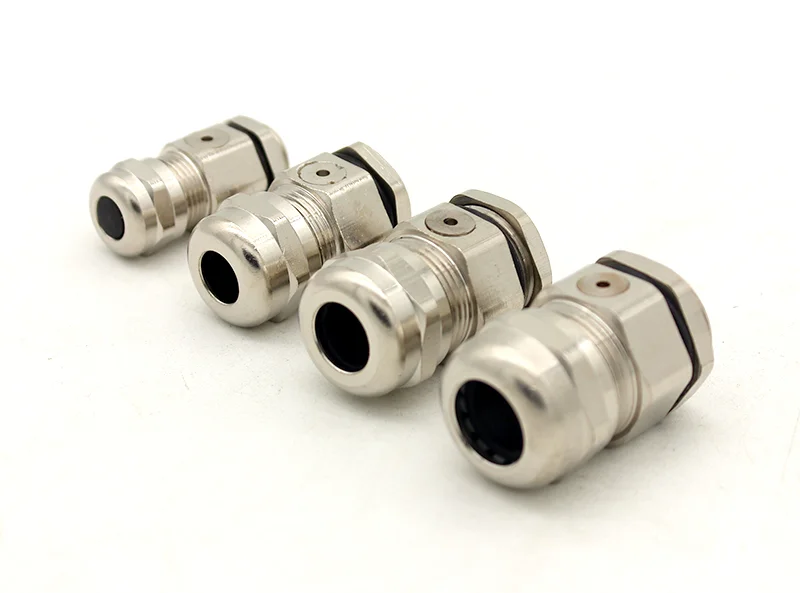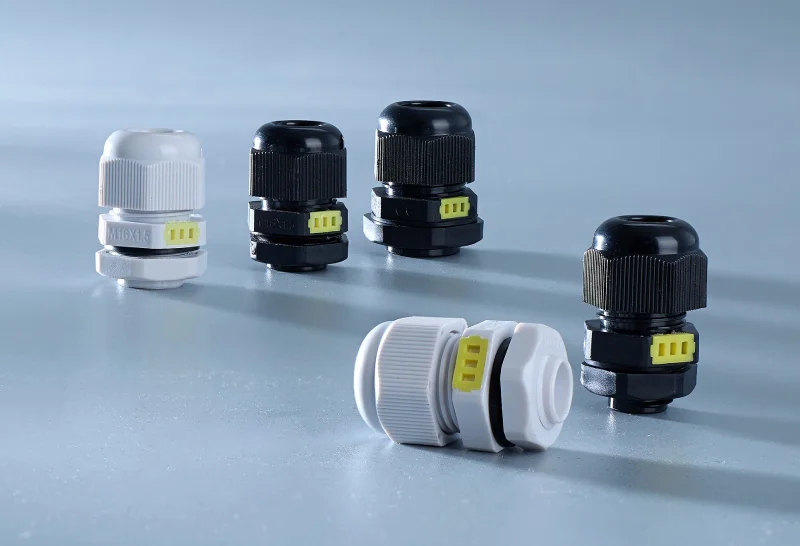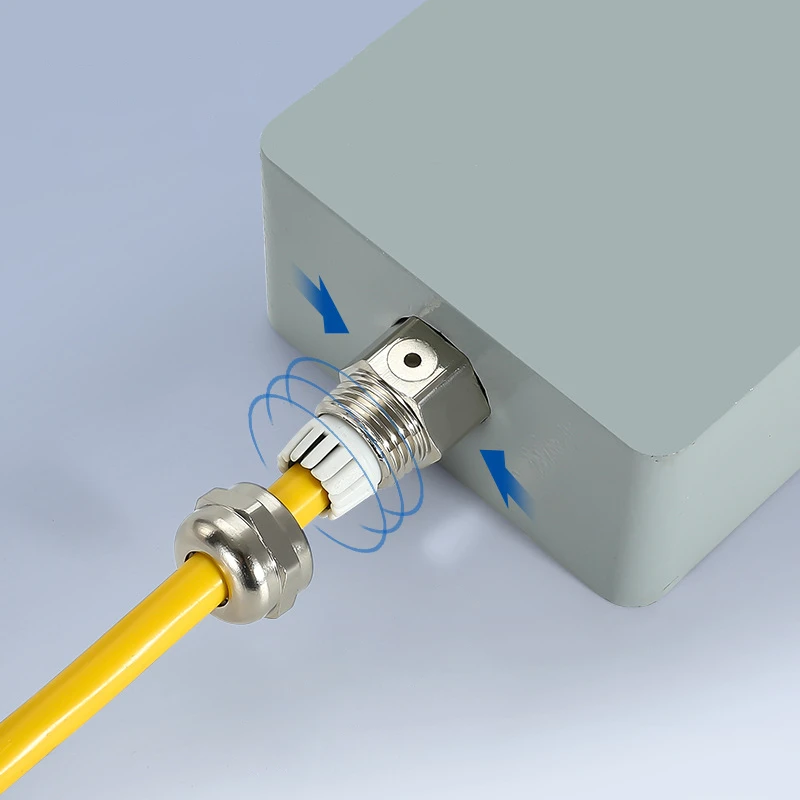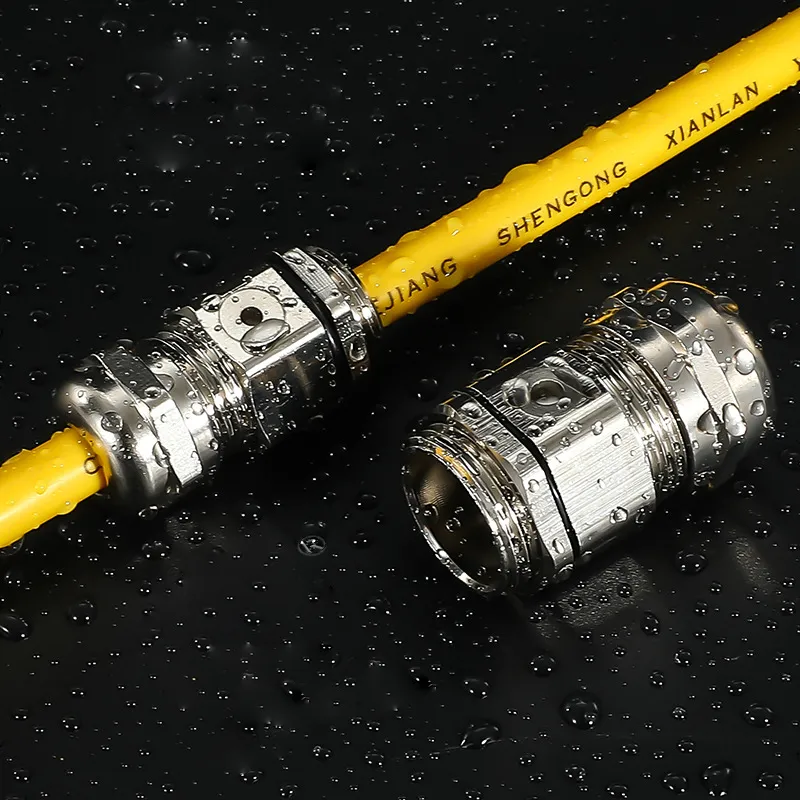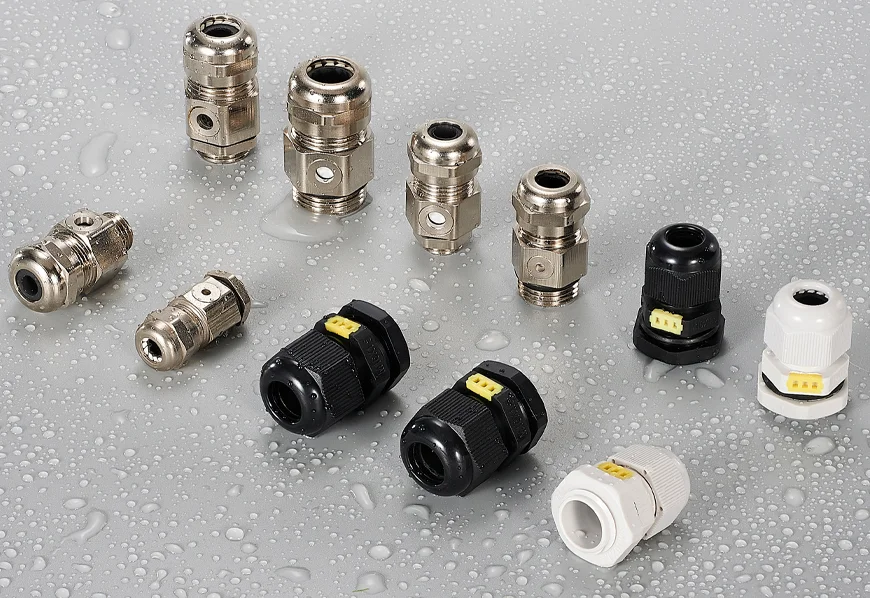Oddychające dławiki kablowe to innowacyjne urządzenia, które łączą funkcjonalność standardowych dławików kablowych z możliwościami wentylacji, oferując unikalne rozwiązanie zapobiegające kondensacji w obudowach elektrycznych przy jednoczesnym zachowaniu ochrony kabli i szczelności środowiskowej.
Czym są oddychające dławiki kablowe?
Innowacyjne urządzenia, które integrują standardową funkcjonalność dławika kablowego z możliwościami wentylacji, oddychające dławiki kablowe oferują kompaktowe rozwiązanie do wyrównywania ciśnienia i ochrony kabli. Te wyspecjalizowane dławnice posiadają:
- Membrana wentylacyjna umożliwiająca wymianę powietrza przy zachowaniu wodoodporności na poziomie IP68
- Zakres temperatur pracy od -40°C do 100°C (krótkotrwale do 120°C)
- Konstrukcja z materiałów takich jak niklowany mosiądz lub nylon PA66
- Dostępność w różnych rozmiarach od M12 do M40
Łącząc zaciskanie kabli i zapobieganie kondensacji w jednym urządzeniu, oddychające dławiki kablowe zapewniają skuteczną ochronę przed gromadzeniem się wilgoci w obudowach elektrycznych, oferując jednocześnie standardowe funkcje dławika kablowego, takie jak odciążenie naprężenia.
Kluczowe oddychające elementy dławika kablowego
Oddychające dławiki kablowe składają się z kilku kluczowych elementów, które współpracują ze sobą w celu zapewnienia ochrony kabli, uszczelnienia i wentylacji:
- Korpus i nakrętka: Zazwyczaj wykonane z niklowanego mosiądzu lub nylonu PA66, tworzą one główną strukturę.
- Pierścień uszczelniający: Zwykle wykonane z kauczuku polichloroprenowo-nitrylowego (CR/NBR) w celu zapewnienia wodoszczelności.
- Wkładka mocująca: Często wykonane z poliamidu PA6 dla bezpiecznego mocowania kabli.
- Membrana odpowietrzająca: Kluczowy element, zwykle wykonany z ePTFE, umożliwiający wymianę powietrza przy jednoczesnym blokowaniu cieczy i zanieczyszczeń.
- O-ring: Wykonane z kauczuku nitrylowego (NBR) lub silikonu dla dodatkowego uszczelnienia.
Komponenty te zostały zaprojektowane tak, aby działały w harmonii, zapewniając stopień ochrony IP68, jednocześnie umożliwiając wyrównanie ciśnienia przez membranę odpowietrzającą. Wybór materiałów zapewnia odporność na różne czynniki środowiskowe, w tym promieniowanie UV, chemikalia i ekstremalne temperatury.
Zasada działania i technologia
Rdzeniem oddychających dławików kablowych jest zaawansowany system wyrównywania ciśnienia wykorzystujący specjalistyczną technologię membran wentylacyjnych. Membrana ta przepuszcza cząsteczki powietrza, blokując jednocześnie ciecze i zanieczyszczenia, tworząc równowagę ciśnień między środowiskiem wewnętrznym i zewnętrznym obudowy. Dławik automatycznie równoważy wewnętrzne i zewnętrzne różnice ciśnień, gdy występują wahania temperatury, zapobiegając tworzeniu się kondensatu wewnątrz obudowy przy jednoczesnym utrzymaniu ciągłej wymiany powietrza.
Kluczowe specyfikacje techniczne obejmują:
- Przepuszczalność rozpraszania ciepła 2400 ml/s/m² przy ciśnieniu 0,02 bara.
- Odporność na ciśnienie wlotowe wody przekraczające 5 barów.
- Zdolność do szybkiego przywrócenia oddychalności po kontakcie z cieczą.
- Odporność na promieniowanie UV, słoną wodę, oleje i agresywne substancje czyszczące.
Rodzaje oddychających gruczołów
Oddychające dławiki kablowe są dostępne w dwóch głównych typach, różniących się materiałem wykonania:
- Niklowany mosiądz: Dławnice te mają mosiężny korpus z niklowaną powłoką, zapewniającą doskonałą odporność na korozję i trwałość. Zazwyczaj zawierają uszczelki NBR (kauczuk nitrylowy) i nylonowy pazur PA66 do mocowania kabli. Ten typ jest idealny do trudnych warunków przemysłowych i zastosowań zewnętrznych ze względu na solidną konstrukcję.
Dławiki VIOX z niklowanego mosiądzu, oddychające
- Nylon PA66: Wykonane w całości z wysokiej jakości nylonu PA66, dławnice te zapewniają dobrą wytrzymałość mechaniczną, odporność na ciepło i odporność chemiczną. Są lżejsze niż ich metalowe odpowiedniki i oferują doskonałe właściwości izolacji elektrycznej, dzięki czemu nadają się do zastosowań, w których waga i nieprzewodzenie są ważnymi czynnikami.
Nylonowy, oddychający dławik kablowy
Oba typy zachowują stopień ochrony IP68 i mogą pracować w zakresie temperatur od -40°C do 100°C. Są one dostępne w różnych rozmiarach gwintów metrycznych, zazwyczaj od M12 do M63, co pozwala na zastosowanie szerokiego zakresu średnic kabli.
Podstawy membran wentylacyjnych
Membrany wentylacyjne są kluczowym elementem oddychających dławnic kablowych, umożliwiając wyrównanie ciśnienia przy jednoczesnym zachowaniu ochrony przed zanieczyszczeniami. Membrany te, zazwyczaj wykonane ze spienionego politetrafluoroetylenu (ePTFE), oferują kilka kluczowych korzyści:
- Przepuszczają powietrze i parę, blokując jednocześnie ciecze i cząsteczki.
- Zapobieganie kondensacji poprzez umożliwienie wydostawania się wilgoci z obudowy.
- Wyrównywanie różnic ciśnień pomiędzy wnętrzem i zewnętrzem obudowy.
- Ochrona wrażliwej elektroniki przed zanieczyszczeniami środowiskowymi.
Mikroporowata struktura membrany ePTFE umożliwia przepływ powietrza określony w litrach na godzinę lub mililitrach na minutę przy określonych różnicach ciśnień. Technologia ta umożliwia oddychającym dławikom kablowym zachowanie ich właściwości ochronnych przy jednoczesnym sprostaniu wyzwaniom związanym z wzrostem ciśnienia i kondensacją w szczelnych obudowach, szczególnie w zastosowaniach zewnętrznych i wrażliwych na wilgoć.
Zalety oddychających dławików kablowych
Oddychające dławiki kablowe oferują znaczące korzyści w porównaniu z tradycyjnymi rozwiązaniami, co czyni je nieocenionymi w różnych zastosowaniach przemysłowych. Ich główną zaletą jest zapobieganie kondensacji poprzez stałe wyrównywanie ciśnienia, co ogranicza awarie operacyjne i kosztowne naprawy spowodowane gromadzeniem się wilgoci. Te innowacyjne urządzenia utrzymują stopień ochrony IP68, jednocześnie umożliwiając wymianę powietrza, skutecznie chroniąc wrażliwe komponenty przed kurzem, zanieczyszczeniami i innymi zanieczyszczeniami.
- Eliminuje potrzebę stosowania drogich systemów wentylacyjnych i otworów ociekowych.
- Wydłuża żywotność złączy kablowych dzięki lepszemu odprowadzaniu ciepła.
- Zapewnia standardową ochronę kabli i funkcje odciążania.
- Szybko przywraca oddychalność po kontakcie z cieczą.
- Zapewnia odporność na promieniowanie UV, słoną wodę i agresywne substancje czyszczące.
Innowacje materiałowe w konstrukcji oddychających dławików kablowych
Najnowsze innowacje materiałowe znacznie poprawiły wydajność i wszechstronność oddychających dławnic kablowych. Zaawansowane polimery, takie jak zatwierdzony przez UL nylon PA66, oferują wysoką wytrzymałość mechaniczną, doskonałą odporność na ciepło i doskonałą odporność na zużycie, zapewniając długotrwałą trwałość w trudnych warunkach. W przypadku opcji metalowych, korpusy z niklowanego mosiądzu zapewniają wyjątkową odporność na korozję i przewodność.
Kluczowe postępy w zakresie materiałów obejmują:
- Membrany ePTFE (ekspandowany politetrafluoroetylen) dla lepszej oddychalności i wodoodporności.
- Odporny na wysokie temperatury silikon do o-ringów, zwiększający integralność uszczelnienia w szerokim zakresie temperatur.
- Warianty ze stali nierdzewnej (304 i 316L) zapewniają ekstremalną odporność na korozję w agresywnych środowiskach.
- Integracja inteligentnych materiałów w celu monitorowania stanu i możliwości konserwacji predykcyjnej.
Te innowacje materiałowe rozszerzyły zakres zastosowań oddychających dławnic kablowych, czyniąc je odpowiednimi dla branż takich jak przetwórstwo spożywcze, farmaceutyczne i instalacje morskie, gdzie wyzwania środowiskowe są szczególnie wymagające.
Zastosowania i historyczne innowacje
Wprowadzony w 2007 roku, pierwszy na świecie oddychający dławik kablowy z wyrównaniem ciśnienia (VentGLAND®) oznaczał znaczący postęp w ochronie obudów elektrycznych. Ta innowacja znalazła szczególną wartość w sektorach podatnych na wahania temperatury i środowiskach wrażliwych na wilgoć, w tym:
- Zastosowania oświetlenia LED
- Instalacje zewnętrzne
- Przemysł żeglugowy i solarny
- Systemy automatyki przemysłowej
- Instalacje ogniw fotowoltaicznych
Zastępując tradycyjne rozwiązania, takie jak elektryczne systemy grzewcze i otwory ociekowe, oddychające dławiki kablowe zrewolucjonizowały zapobieganie kondensacji w obudowach elektrycznych, oferując bardziej wydajne i ekonomiczne podejście do kontroli wilgoci i ochrony kabli.
Wyzwania i rozwiązania związane z instalacją
Najczęstsze problemy i błędy podczas instalacji dławików kablowych obejmują:
- Nieprawidłowe przygotowanie kabla: Nieprawidłowe usunięcie izolacji z kabla lub usunięcie niewystarczającej ilości powłoki zewnętrznej może prowadzić do słabego uszczelnienia.
- Nieprawidłowy wybór dławika: Wybór dławika o niewłaściwym rozmiarze lub stopniu ochrony IP dla danego zastosowania może obniżyć poziom ochrony.
- Nadmierne dokręcanie: Nadmierna siła podczas dokręcania dławika może uszkodzić kabel lub sam dławik, zmniejszając jego skuteczność.
- Zaniedbanie membrany odpowietrzającej: Uszkodzenie lub zablokowanie oddychającej membrany podczas instalacji może osłabić jej funkcję wyrównywania ciśnienia.
- Niewystarczające wsparcie: Niezapewnienie odpowiedniego podparcia kabla może zwiększyć obciążenie dławika, potencjalnie narażając jego uszczelnienie w miarę upływu czasu.
Aby uniknąć tych problemów, należy dokładnie przestrzegać wytycznych producenta, używać odpowiednich narzędzi i upewnić się, że środowisko instalacji jest czyste i suche. Regularna kontrola i konserwacja zainstalowanych dławnic ma również kluczowe znaczenie dla długoterminowej wydajności i bezpieczeństwa.
Powiązany produkt:
Powiązany artykuł :
Pełny przewodnik po dławikach kablowych z niklowanego mosiądzu

